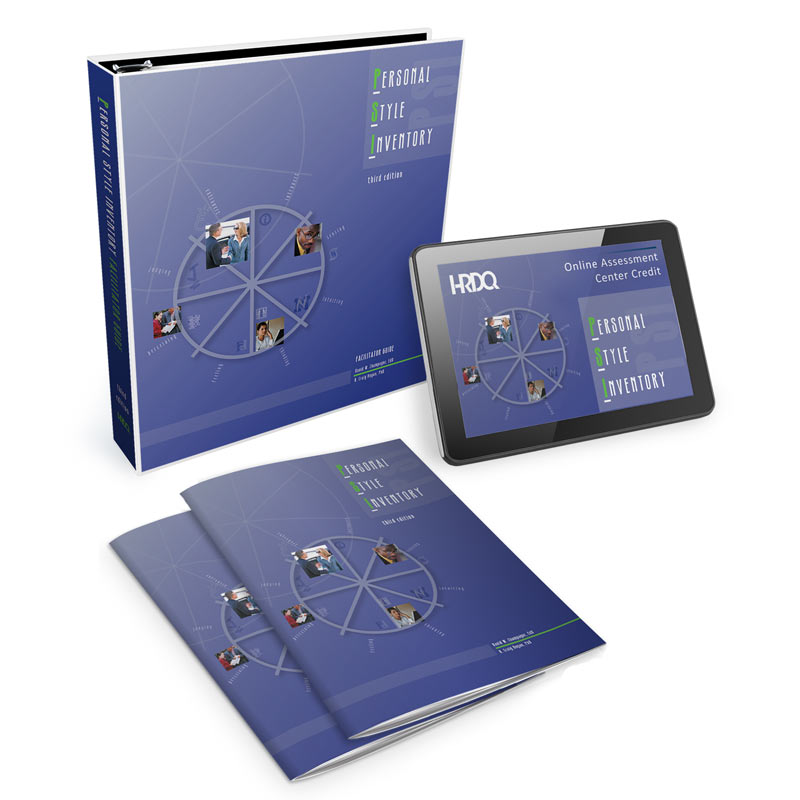PERSONAL STYLE INVENTORY

3rd Edition
by R. Craig Hogan, PhD
and David W. Champagne, EdD
Available in both Online and Paper-Based Format
Self-understanding is a necessary prerequisite for learning, growth, and getting along with others. Because without it, no amount of formal training or on-the-job experience will enable people to reach their full potential - or improve their relationships with peers, coworkers, and managers. Blind to their own behavioral patterns, they will continue to trip over themselves in the same old ways. So, as a trainer, where do you begin?
A bestseller for more than 25 years, the Personal Style Inventory (PSI) is an accurate, statistically reliable personality-style assessment and classroom workshop that reveals an individual's dominant personality style and sheds useful light on the critical question: Why do I behave the way I do?
Based on Carl Jung's well-known personality theory, the PSI identifies deep-seated style preferences along four paired dimensions:
- Extraversion or Introversion
- Sensing or Intuiting
- Thinking or Feeling
- Perceiving or Judging
The PSI makes it easy for people to “see” how they think, act, and feel. And with their eyes wide open, you've taken the first step toward improving your organization's communication, team work, leadership, and interpersonal relationships.
Learning Outcomes
- Identify an individual's dominant personality style
- Learn about the 16 different personality styles
- Discover the characteristics, strengths, and potential blind spots of each style
- Understand how each style interacts with the others—and how to improve these relationships
- Discover what types of tasks are suited—or not suited—to each personality style
- Develop an action plan to improve performance and relationships with others
It's simple, really. Using either the print or online self-assessment, individuals respond to a series of 32 statements that relate to four paired dimensions:
- Extraversion or Introversion
- Sensing or Intuiting
- Thinking or Feeling
- Perceiving or Judging
The result is a personality-style profile that is abbreviated by a combination of four letters symbolizing a preference for each dimension (i.e., ISTP = Introversion/Sensing/Thinking/Perceiving). The self-assessment takes 15 minutes to complete, and we recommend you allow at least one hour for the interpretation of results, debrief, and action planning. You can also extend the learning into two half-day training programs—one for individuals and one for teams—using the workshop instructions and PowerPoint presentation included with the Facilitator Guide. Trainer certification is not required to administer or facilitate the PSI.
What are the differences between the PSI and other Jungian-based assessments?
Although these instruments use the same theory to measure personality style, the PSI asks individuals to assume a different frame of reference. While other Jungian-based assessments attempt to measure how people usually behave, the PSI measures how people prefer to behave. We believe this unveils a style closer to the true nature of the individual's personality style. In addition, the PSI measures the relative strengths of each dimension, which is more helpful to individuals than the either/or results presented by other Jungian-based assessments.
Uses and Applications
The PSI is effective as a stand-alone learning instrument or part of a more comprehensive training program. The PSI can be used as a:
- Centerpiece of a communication or leadership development program.
- Discussion starter for individual and personal counseling.
- Diagnostic instrument for career planning and job selection.
- Tool for mapping a team profile and improving group dynamics.
Product Type: Print and online assessment
Measures: An individual's dominant personality style
Dimensions:
Extraversion/Introversion
Sensing/Intuiting
Thinking/Feeling
Perceiving/Judging
Time Required:
Administration: 15 minutes
Interpretation: 1 hour
Workshop: 3 hours